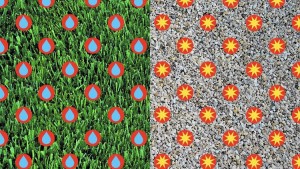Jun
“Don’t Gravelscape L.A.”
We came across this article that ran in the Los Angeles Times last weekend called Don’t Gravelscape L.A.
They make some GREAT points! Before you consider ripping out your lawn, please read this article and we bet you will change your mind! We are in a drought, and we need to be water savvy. But you can still have a lawn! Really!
People are starting to panic about their lawns. The Metropolitan Water District is adding $350 million to its lawn removal rebate program and homeowners are scrambling to rip out grass and replace it with something easy and oh-so drought tolerant — gravel or artificial turf. At least one lawn removal contractor promises to do it for free (the company cashes in the rebate).
Drought panic and rebates incentivize too many quick and dirty solutions for our water crisis. All over the city — and especially in park-poor areas, where postage-stamp lawns may be the only relief from pavement — we have to think before we act. Will exchanging a living, breathing yard for a bleak gravelscape save water? Some. But is it the only way? Is it the right way?
Before you call the gravel truck, here are a few things to consider.
Read the rest of this entry »
Jun
Spring/Summer Transition and Your Lawn
We all know that transitioning from ryegrass back to a warm season grass is difficult (especially for California and Arizona sod), but throw in some cooler than normal weather and now you have a battle. Every year the producers of ryegrass seed seem to make their seed a little more heat resistant in search of that year round turf. The problem with this is that we’re shortening the growing window of our warm season turf. Not to mention that cool season grasses in the desert areas use much more water than the underlying warm season turf. The solution is to aide your lawn in transition, and to get your lawn free and clear of ryegrass in the next couple weeks.
Before I go into techniques to remove ryegrass I want to make a couple points about how the average lawn looks at this time of the year. We all love our winter lawn for its color, texture, and feel, but it’s important to remember that it puts agronomic stress on your lawn. When you have two different grasses competing for nutrients, water, and sunlight you’re bound to have an “ugly period.” The turf world refers to this as the transition period. This is the period of time when the cool season grass is starting to die off slowly and the warm season grass is trying to emerge. What creates the ugly period is the competition.
Comments Off on Spring/Summer Transition and Your LawnMay
Saving Water on Your Lawn and the Benefits of Natural Turfgrass
SAVING WATER………
Everyday we are reminded that we are in a drought situation. My last few blogs have been about this same subject, and I think it is important to continue with the topic.
The press is convinced that ripping out your lawn is the answer. But is it? No. You can have an environmentally beneficial lawn and use water wisely! Here are some more tips on how to save water while still keeping your lawn alive during our historic drought: Read the rest of this entry »
Comments Off on Saving Water on Your Lawn and the Benefits of Natural TurfgrassMay
Water Restrictions and Your Lawn. What Now? PART-2
So here we are, May of 2015, and for the first time in many of our lives we are being asked to cut our water usage by at least 25%. As I alluded to in PART-1 of using water wisely (please click here to read PART-1 if you have not already) many people view water consumption solely as an agricultural problem. It is easy to look at the percentages of water used by the agricultural industry and blame them for the water shortage, but have you considered that the real problem lies within us.
Did you know that over the past ten years the agriculture industry has lowered their water use rate from as much as 90% to less than 69% of total water consumed? Again many of you will look at the percentage of water used and say it is still too high, but the homeowner use rate has skyrocketed, while agriculture has learned to adapt and change.
Did you know the average family of four wastes 10,000 gallons of water a year waiting for hot water to arrive to their shower? Right there you can save 6% of your yearly water use. I know we’re supposed to be talking about landscape water rates, but more needs to be addressed than simply blaming one industry. I will be the first to tell you landscape water use rates need to go down. The average household wastes 16,000 gallons of water per year overwatering their landscapes. This is an additional 9% of your yearly water total being wasted. Today I will be giving you directions on how to not only save the 9% of overwatering, but I will also give you ways to save another 10% by watering smarter and using proper agronomic practices. I would be remised if I didn’t say this before I begin. Grass doesn’t waste water, people do. Read the rest of this entry »
Comments Off on Water Restrictions and Your Lawn. What Now? PART-2


